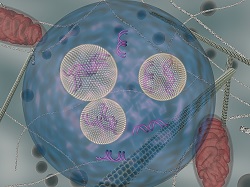 |
| siRNA strands in nanoparticles transported in an endocytic vesicle--Courtesy of MIT |
Researchers at MIT are working on new ways to carry RNAi drugs via liquid nanoparticles that would maximize their delivery and their ability to silence malfunctioning genes that can lead to cancer.
A Nature Biotechnology journal-published study, the authors of which include professor and entrepreneur Robert Langer, demonstrates the ability of lipid-based nanoparticles to package strands of RNA, called siRNA, to enter cells without getting trapped in small bubbles there called endocytic vesicles, hindering their performance, according to a report from MIT. This is a common problem in the delivery of RNAi drugs, which are otherwise a promising prospect in personalized medicine.
The researchers sought to create "traffic jams" of nanoparticles in the cells by denying the drug vehicles a particular protein, NPC1, which normally causes them to be excreted quickly. By designing them to stay in the cell for a longer amount of time, the siRNA has more time to reach the cell's genetic material and perform its function. This gave a 10- to 15-fold boost to RNA interference, according to the report.
"We've been able to develop nanoparticles that can deliver payloads into cells, but we didn't really understand how they do it," said MIT Professor Daniel Anderson in a statement. "Once you know how it works, there's potential that you can tinker with the system and make it work better."
The researchers are developing the process to further enhance RNAi delivery, focusing on ways to hinder nanoparticle recycling in the cells.
"This paper describes a new and very important way to improve the potency of siRNA delivery systems by inhibiting proteins that recycle imported material back out of the cell," said unaffiliated biochem professor Dr. Pieter Cullis of the University of British Columbia. "It is possible that this approach will give rise to the order-of-magnitude improvements in potency required for siRNA-based therapeutics to be more generally effective agents to treat disease."
- here's the MIT report
- and here's the Nature Biotechnology study